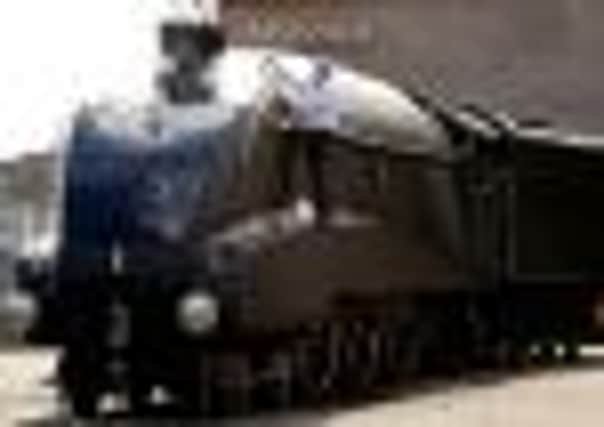Class act as Mallard to line up with sisters for reunion


On July 3, 1938, the mighty blue Mallard became the first steam locomotive in history to reach the awe-inspiring speed of 126mph on the East Coast Main Line, breaking the German record of 124mph set in 1936.
With Hitler’s Third Reich then in the ascendancy, it was a matter of national pride and national security that a British locomotive captured the world speed crown.
Advertisement
Hide AdAdvertisement
Hide AdNo 4468 Mallard, which had recently been built at LNER’s Doncaster Works as the first of the class to be fitted with a double chimney, was chosen as the perfect vehicle for the endeavour.


The speed, achieved while on a run down Stoke Bank, north of Peterborough, still stands as the world steam record.
Now in the run-up to a series of celebratory programme of events in 2013 to mark 75 years since Mallard broke the world speed record, the blue locomotive has undergone a somewhat unusual paint job.
Workers have spent four weeks applying 55 litres of paint to the steam locomotive, to give her a sleek new black look.
Advertisement
Hide AdAdvertisement
Hide AdThe work has been carried out at the National Railway Museum in York in readiness for a meeting with her sister A4 locomotives, Dominion of Canada and Dwight D Eisenhower from the USA, who are returning to British soil in September for the first time in over half a century.
The centrepiece of the 75-year celebrations will be a never-before-seen line-up of all six of the only surviving A4 locomotives in the world.
In March, the museum reached a formal agreement with museums in Canada and the US to bring the two A4 class locomotives home to the birthplace of the railways where they will stay for two years.
To ensure they too are looking up to scratch, the Dominion will receive a full cosmetic overhaul and Dwight D Eisenhower will undergo cosmetic restoration.
Advertisement
Hide AdAdvertisement
Hide AdSteve Davies, director of the National Railway Museum, said: “We wanted to do something really special to mark the 75th anniversary and what could be more spectacular than an international family reunion for the A4s.
“When these mighty machines were exported across the Atlantic in the Sixties, no-one thought they would ever come back.
“Now the planning of their journey to the UK is well advanced.”
Mr Davies added: “The sheer scale of this project to move these locomotives back to home soil is immense and it is testament to the vision of the National Railway Museum and our transatlantic colleagues that we are able to make this happen.”
Advertisement
Hide AdAdvertisement
Hide AdThe A4s were designed by Sir Herbert Nigel Gresley in 1935, after an A3 class Papyrus showed steam could pull a six-coach train from London to Newcastle in 230 minutes. This meant that a four-hour trip was possible given the right engine.
As a result of their performance, an order was placed for 17 A4s, followed by a further deal for another 14.
The service was inspired by the German “Flying Hamburger”, at that time the fastest scheduled train in the world.
These 31 engines were delivered between December 1936 and July 1938
Advertisement
Hide AdAdvertisement
Hide AdFive were named after constituents of the Empire and allocated to operate the six-hour London to Edinburgh service.
No. 4492 Dominion of New Zealand was part of a batch of A4 locomotives that were designed to celebrate the Coronation of George VI.
It was not until the early 1960s that the A4s stopped working major routes – one had been destroyed during an air raid at York in April 1942 and the remainder were withdrawn between 1962 and 1966.
Of the six that have been preserved, four still remain in Britain – 4498 Sir Nigel Gresley, No.60009 Union of South Africa, No.60019 Bittern and 4468 Mallard.
Advertisement
Hide AdAdvertisement
Hide AdMallard was in service until 1963, when it was retired having covered almost one and a half million miles.
The locomotive was restored to working order in the 1980s, but has not operated since, apart from hauling some specials between York and Scarborough in July 1986, a couple of runs between York, Harrogate and Leeds around Easter 1987, and a 50th anniversary outing on the rails in 1988.
Mallard is the only surviving A4 in LNER livery and in as-built original condition with side valances (although the valances are replicas).
The world record-breaking locomotive was yesterday put temporarily on display to visitors at the museum.